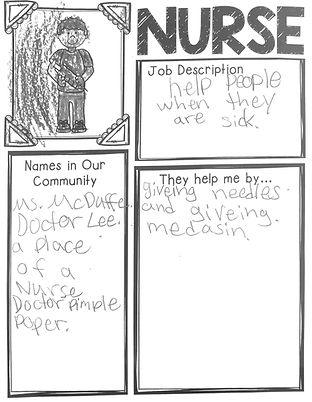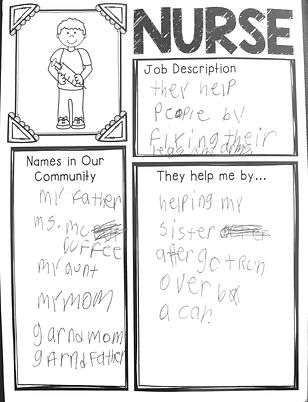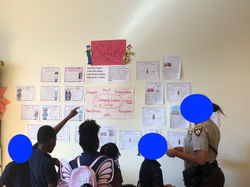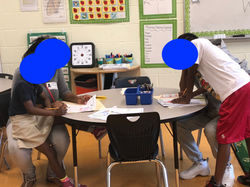Johanna Busch
Community Helpers
Every morning, my students answer a journal question while they eat breakfast. One morning last spring, my students responded to the question "What do you want to be when you grow up?". My students were really excited to write about this topic. Most of my students wrote about a very limited number of careers. They wanted to be famous Youtubers or NFL quarterbacks. While my students are incredibly talented and may end up being successful in these careers, I wanted them to be aware of all the other career possibilities that they could pursue. I decided to plan a two-month long project exploring community helpers. There were two main goals of this project. First, students would be able to explore how different community helpers influence their communities. Second, students would be able to explore what careers they might want to explore when they grew up. At the end of the projects, students would present what they learned
Because many of my students come from neighborhoods that have historically been disinvested in and underserved, my students don't necessarily have exposure to and connections with adults in a wide range of different professions. I hope that by learning about and meeting people in different professions, students could start envisioning a broader range of career options for themselves. This project opened doors for students by connecting them to personal experiences with firefighters and nurses and providing them with knowledge about other career paths.
Though students explored a variety of community helpers in safety, art, education, and health over a two month period, this page will focus on firefighters and nurses. This is because students had the most increased access to these two professions through a field trip and guest speaker.
Research
Based on my students responses to their journal question about what they wanted to be when they grew up, I realized I needed the best ways to expose students to different careers. I conducted online research and decided that the best way for students to learn about different careers was through education and exposure. This would involve teaching students about different careers and giving them opportunities to meet people in some of these careers.
Multiple articles suggested that giving students opportunities to interact with professionals from their communities would help them to explore different career options (Kaskey, 2012) (Brown-Huston, 2014) (Ting et al, 2012). Click on the citations to read the full articles. Kaskey (2012) suggests that a career day event provided students with valuable information about possible careers. Though career exploration is often only offered to high school students, Brown-Huston & Wilkerson (2014, p.2) write that "it is particularly important to provide early elementary access to career development programming for groups at risk due to socioeconomic factors". Brown-Huston & Wilkerson (2014) suggest that students should begin exploring their interests and career possibilities. Students can explore these possibilities by learning about and meeting a variety of different professionals from their school community. Ting et al. (2012) suggests that middle school students who participated in a long term project around science careers increased their science skills and were more interested in pursuing a career in science. Based on these articles, I decided to plan a long term project that would go beyond just a career day. Students would learn about a variety of different careers and be provided with exposure to a nurse and firefighters.
Planning
During March, I created a long term plan for this project. A field trip to the fire department and a visit from a nurse guest speaker were planned. The culmination of the project would involve students families and community members coming in to hear students present about a community helper of their choice.

This is the calendar that I created to plan the community helpers project. I made sure to plan to ensure that students had the relevant background knowledge that they needed to get the most out of the guest speaker and field trip.
I invited a nurse, who was a family friend of another teacher, to come present over the phone. Below are emails confirming that I did invite her and that she did come present to our class last spring.
Though our school nominally has a nurse, she does not have a degree in nursing. She is also not very open to talking with students. Because of this, bringing in a nurse who was willing and excited to share her passion for her profession constituted an outside opportunity for my students. Though our school nurse might sometimes give them a bandaid, she is not open to talking with them about her role as a nurse or their possible interest in this career.

Here is an email I sent to Ms. Montagu confirming that she presented to my class last year.

Here is Ms. Montagu's response confirming that she presented to my students last year.

Here is an email I sent to Ms. Montagu confirming that she presented to my class last year.
To schedule the field trip, I contacted the fire station down the street from my school through their online form. I then followed up over the phone and in person. The field trip was scheduled for the afternoon of May 10, 2018.

The above screenshot shows an email from a firefighter confirming that the second grade from Monarch Academy visited the fire station.

Attached is an image of the walking field trip permission slip that I sent home to allow students to participate in the field trip to the fire station.


Here is a picture of the form I filled out to notify the school nurse of our walking field trip.

Attached is an image of the walking field trip permission slip that I sent home to allow students to participate in the field trip to the fire station.
The above slideshow displays several forms that I filled out to plan and prepare for the walking field trip to the fire department.
I also planned a morning for families and community members to join our class to see students' work and hear them present what they learned about community helpers. To plan for this day, I confirmed the date with my administration and sent the below flyer home to families and community members (such as the nurse and firefighters we met). I wanted the presentations to be an inclusive opportunity for students to share what they learned with an authentic audience and potentially connect with community members of other professions.

The above image is the flyer that I created and sent home to families and community members inviting them to join us for our community helper presentations.
Nurses
Students learned about nurses during a two week exploration of community helpers in health. Learning about doctors, dentists, and veterinarians encouraged students to take advantage of the opportunity of having a nurse guest speaker by giving them the background knowledge they needed to get the most out of the experience. Students brainstormed different members of our community who help keep us healthy and watched a Brain Pop Junior video about going to the doctor.

Here is a screenshot of a Brainpop Junior video that students watched about community workers in health. The full video can be found here.
Next, students learned some additional background knowledge about what nurses do. Students watched the below video and read a text. Students then used what they knew and their pre-existing knowledge to create brainstorming maps. We used the brainstorming maps to come up with a list of questions they wanted to ask the nurse when she visited.
Here is the musical video that students watched to get a basic introduction to what nurses do.

This student included more information learned from the video and reading, such as nurses using thermometers and needles.

This student primarily included her own prior knowledge about nurses, including the name of our school nurse.

This student included more information learned from the video and reading, such as nurses using thermometers and needles.
Here are some brainstorming map students created based on their own prior knowledge and information learned in class.
Once students had prepared and gained background knowledge, the nurse came in as a guest speaker. She spoke to two different second grade classes about her own experience going to college and becoming a nurse. She talked about her job as a nurse at an internal medicine practice. She gave students some health tips. She also brought some supplies such as gauze, syringes, a stethoscope, and latex gloves that she uses frequently. She also answered questions which students had prepared earlier this week.

In this photo, the guest speaker had just asked how many students knew a nurse.

In this photo, the guest speaker had begun taking questions about her job from students.
After the nurse visited, students reflected on what they had learned. Students discussed whether they would want to be a nurse or not and how nurses contribute to our community. Students recorded their thoughts in a short writing assignment. They wrote about what nurses do, how they help us, and nurses that they know. Their student work is shown below.

This student wrote about a nurse she knew from popular culture.

This student wrote about a nurse who helped her family when her sister got run over by a car.

This student said a nurses job is to "help people when they are hurt," which is how our guest speaker explained it.
Teacher Reflection
I was surprised by how powerful it was for my students to interact with the nurse who came in as a guest speaker. She was very engaging and did a great job describing what she did in student friendly language. Since students had learned some background knowledge before she visited, they were able to ask informed questions both about what it is like to be a nurse and how they could be more healthy. After her visit, many students expressed interest in becoming nurses themselves. Seeing how impactful her visit was made me wish I had invited other guest speakers such as doctors, dentists, or EMTs. Meeting someone in this profession gave my students the opportunity to ask their own questions. It helped them to envision themselves as nurses. Bringing in a nurse guest speaker gave my students access to a person in a career that they would not otherwise have had the opportunity to learn about.
Firefighters
When my students first started learning about community helpers, they were the most excited about learning about firefighters. Because of this, I worked with the second grade team to plan a field trip to a fire station. A field trip to the fire station would give students access not only to a person in a specific career (as the nurse visit did) but the ability to actually see community helpers in their place of work. This experience exposed students to a career path that could potentially open doors for them in the future.
Students first created brainstorming charts about what they already knew about firefighters. Then, students read My Mom is a Firefighter by Lois G. Grambling, read some texts about fire fighters, and watched videos of firefighters in action. This helped students build the necessary background knowledge that would encourage and allow them to get the most out of the field trip to the fire station.

This student recorded prior knowledge he had about firefighters such as "They have a chief."

This student didn't have a lot of prior knowledge about firefighters. He recorded similar information in every circle.

This is the work of one of my lowest students who often refuses to write. However, this student was so excited to learn about firefighters that he wrote several facts about them.

This student recorded prior knowledge he had about firefighters such as "They have a chief."
Here are some brainstorming map students created based on their own prior knowledge about firefighters.
Here is the video read-a-loud of the story My Mom is a Firefighter by Lois G. Grambling that my students listened to before our field trip.
Reflecting on the nurse guest speaker, I realized that my students would get even more out of the fire station field trip if they had more time to explicitly think about what they were curious about. Because of this, the day before the field trip we talked as a class about what we wanted to learn from the firefighters during our field trip. Students then each had a chance to write down four questions that they wanted to ask during the trip. I had students write down individual questions to encourage them to fully participate in the firefighter field trip and to get the most out of an opportunity to see a real fire station and interact with firefighters.
Here are some samples of questions students wanted to ask firefighters. Click on the images to see larger versions of the student work.

This student wanted to ask if he could try on the firefighter's hat and go down the fire pole,

This student wondered if firefighters get burned in the fire.

This student asked how it would feel to be a firefighter.
On May 10, 2018, students went on a field trip to the fire station. Students had the opportunity to tour the fire station. The firefighters showed students all of their tools and gear, explaining how they put out fires. They also discussed the more behind of the scenes aspects of their jobs. They showed students the gym they work out in and the kitchen they cook meals in when they are not responding to an emergency. They also discussed with students whey they became firefighters and the parts they like and do not like about the job. Students were able to learn both about what firefighters do on a daily basis and how these people became firefighters. Students were also able to ask the questions that they planned out the day before.

Here is an image of a firefighter letting students touch some of the gear they use to get into burning buildings.

Here is an image of a firefighter showing students all of the parts of a firetruck and what they keep inside of it.

Here is an image of a firefighter showing students what their full firefighting gear looks like.
Above are images from our field trip to the fire station. Click on the images to see larger versions.
After students went to the fire station, we reflected on what they learned in a class discussion. Students shared whether they would or would not want to be firefighters based on what they learned from the field trip. After our discussion, students responded to this writing prompt. Many students wanted to be firefighters so that they would have a chance to save people. Other students did not because of the long shifts that fire fighters have to work and the danger that they are in.
Above are student responses to the questions "Would you like to be a firefighter? Why or why not?" Click on the images to see larger versions.

This student wants to be a firefighter to save people.

This student wants to be a firefighter so that she could save members of her family if there was a fire.
After learning about firefighters and visiting the fire station, I recorded several students reflecting about the experiences. The students discuss what they learned about firefighters, their favorite part of the field trip, why firefighters are important, and whether or not they would like to be a firefighter when they grow up. Students said that they loved seeing the fire trucks, tools, uniforms, and the firehouse dog. Students said that firefighters help keep our community safe by using special tools to put out fires safely. Click below to listen to these reflections.
Community Presentation
To conclude our project on community helpers, students invited family and community members to our classroom on May 30th. Each student was able to choose one area and work in groups to prepare a short presentation for families about what they had learned about community helpers in safety, education, art and safety. Students shared their own writing and experiences learning about community helpers. Each student also prepared a portfolio of their own work. Students shared with visitors what they wanted to be when they grew up and why.
 Students present what they learned about community helpers in education to a community member. |  Students present what they learned about community workers in safety to a mother who works as a police officer, giving her a chance to talk about her own career. |
|---|---|
 One student shows off her contribution to the mural our class created when learning about how artists help our community. |  Students present the mural our class created after learning about how artists contribute to our community. |
 This is an image of students practicing presenting about community workers in health before guests arrived. |  Two students show their porftolios, including the writing piece about what they want to be when they grow up, to their parents. |
Here are images of students sharing what they learned about community helpers with family and community members. Click on the images to see larger versions.
As mentioned above, on the presentation day, students shared pieces the wrote about what they want to be when they grow up. Some students wrote about professions we learned about in class, and some wrote about other professions. Every student was able to share their thoughts with either a family or community members Watching my young students share their hopes for the future with others was inspiring. Multiple parents told me that they thought their children were too young to have serious conversations about their careers. They were shocked both by the intelligent questions their children asked them about their own careers and their children's ability to discuss why they might be suited to particular careers with so much confidence and poise. Though they are very young and will probably change their mind about what they want to do with their lives dozens of times, this project allowed many students to start seriously considering their careers for the first time.

This student wants to be a designer because it makes her "stress go away."

This student wants to be a lawyer to help "people that are getting locked up when they don't deserve to get locked up."

This student wants to be a dentist to clean people's teeth so that they are more healthy.

This student wants to be a nurse so that she can help her family members when they get sick.

This student wants to be a social worker to help kids when people hurt them. He also wants to have lunch bunch with kids.
Here are a few student responses to "What do I want to be when I grow up?" Students shared these pieces with community members on the presentation day. Click on the images to see larger versions of the student work.
Conclusion
In conclusion, the career and community helper project opened doors for students by allowing them to explore a variety of different professions. Students dove even deeper when learning about nurses and firefighters by hearing from a nurse guest speaker and visiting a fire department. Though students might have tangentially learned about these community helpers without me as their teacher, they would not have been able to deeply dive into this subject without my leadership. I planned the guest speaker and field trip which allowed the students to build personal connections and experiences with community helpers. I also planned a community presentation day, where students were able to share what they learned with their family members. These experiences gave students access to the knowledge, experiences, and language they needed to articulate what they want to do when they grow up.
Multiple family members told me that they had not talked about future career prospects with their students before this project. Though my students are young, giving them the opportunity to have these conversations with their families from an early age will hopefully open doors for them. If students are thinking about potential careers from an early age, they will be more able to make choices (such as what middle and high schools to attend) that will help them to get there.
References
Brown-Huston, H., & Wilkerson, K. (2014). Closing the Loop: Incorporating Program Evaluation Into an Elementary School Career Day. VISTAS. Retrieved from https://www.counseling.org/docs/default-source/vistas/article_59.pdf?sfvrsn=2c677d2c_10.
Kaskey, V. (2012). An Investigation into a Career Day on a Student's Choice of Profession. International Journal of Business and Social Science. Retrieved from http://ijbssnet.com/journals/Vol_3_No_14_Special_Issue_July_2012/6.pdf
Ting, S.R. (2012). A Preliminary Study of Career Education in Middle School. Journal of Career and Technical Education. Retrieved from https://ejournals.lib.vt.edu/JCTE/article/view/562/793